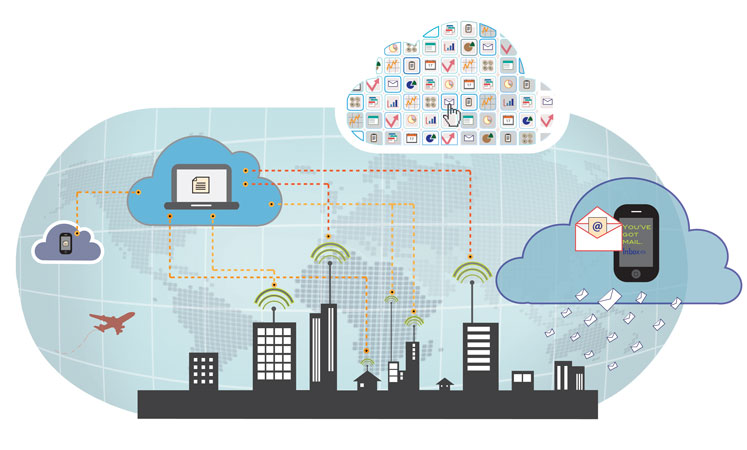One of the most important CIO agenda items for 2012 is addressing and managing employee-owned mobile devices. This is where productivity, cost and security intersect on a scale larger than any other IT initiative for executive management.
Often times IT is a secondary priority amid the corporate agenda. But getting the IT operations aligned with strategy is pivotal to the long-term growth and viability of a company. One of the most important CIO agenda items for 2012, if not the most important, is addressing and managing employee-owned mobile devices. This is where productivity, cost and security intersect on a scale larger than any other IT initiative for executive management. Imagine if the CIO could deliver assurance to a board of directors and executive management team that the invested IT platform was a competitive differentiator based on the productivity gain of every employee while reducing costs for the next three years. The historical mandate of the CIO and IT organization to be a support and risk mitigation role would shift to a role focused on competitiveness and employee return. This is where CIOs will differentiate themselves in the next three years. At the forefront of this expanded CIO role and contribution to the business will be developing an integrated strategy and operation that catapults employee use of personal devices, applications, and social media all within a constant mobile working mode. Cloud computing is one of the fundamental building blocks for achieving this step function gain in productivity at a lower cost of operations.
Past is not a prologue
For IT managers, the past may seem like a gentler, simpler time. The selection and deployment of employee enabled technologies (e.g. PCs, Apps, email) was held by a select few in the IT department. Essentially the IT authorities determined your laptop and handset choice in the name of efficiency, cost and control. They also determined how and when you got the laptop and phone. It was a tried and true model that included servers housed in data centers where IT personnel set the policies and ensured email, security and applications were all running on the laptop. Nowhere in the list of functional requirements were things like easy to use, helps users do their jobs better, or enjoyable experience for users. The top IT manager making the buying decision wasn’t terribly concerned with implementation times, either. However, across all dimensions, CIOs are now facing a more sophisticated employee and an ever-increasing pace of change while losing control over the computing environment.
Disruptor Number One – Delivering software as a service
Arguably the second most critical internal app – email being the first – in an organization is the customer relationship management (CRM) system. The CRM system is the repository of customer information, forecasts, customer contracts, and confidential data of the entire organization. More than one decade ago, Salesforce.com changed the model in CRM by enabling executive management and the sales organization to access this information anywhere, simply from a web browser. Salesforce.com built a multi-tenant, hosted platform where there was none before.
While Marc Bienioff and Salesforce.com’s marketing message was “No Software,” the essence of the disruption was no servers needed to be installed. The cost, speed, maintenance and end-user usability was all superior to traditional CRM solutions even if the features were the same or even sometimes inferior to the legacy systems of Oracle, Siebel and others.
Fast forward to today and we see end-users and departments using software as a service (SaaS) and other cloud resources for a wide variety of applications, without the need for IT. The “consumerization” of enterprise software is well underway. In today’s mobile and Internet-driven world, consumers can easily access applications and use them on their own. Their expectations are that the software they use at work will be equally powerful, simple and engaging. Clearly, the delivery model has changed but IT still plays an important role to ensure security, reliability, compliance, and integration.
Disruptor Number Two – The CEO wants email on his iPhone
In the early 2000’s, the first BlackBerry and Palm Treo devices were in the market. These devices represented a huge advantage for the employees who performed most of their business outside of the office, namely executives and the sales organization. The interesting fact here relating to cloud computing is that these technologies from a management standpoint were still server-based, housed inside the corporate data center or IT equipment closet. Even if you were a 50 person advertising company or a local government representing 10,000 citizens you needed to install the server and maintain it. So while a new preferred employee device was entering the domain of IT, there was still peace, tranquility and control for the server operations team. All was well.
Apple’s first iPhone arrived in 2007 and many companies told their employees that the device was not appropriate for the workplace. They declared Apple products fringe for business. We know how this story plays out but the most interesting point here is that Apple and the iOS platform was server-less. Apple is about individualism and personal freedom in its design philosophy which calculatedly or not, resulted in application program interfaces (APIs) versus servers to manage iOS. The employee could get email and applications for iPhones and now iPads without IT needing to install some sort of on-premise server.
The disruptive nature of mobile devices is now hitting the network and data center operations department. Case in point: The CIO is requested to give email access to the CEO on her iPhone. IT accommodates of course and now everyone with iOS devices gets access to corporate email which is still the number one killer app in a company. The crack in the IT wall is now open and from a server-less technology again. Note that I have seen hundreds of customers in the last year not even realize how many of their own employees were accessing corporate email on their personal iPhones and iPads. I call it the “self revelation moment.” They deploy a tool to discover the number of devices with email access. It tends to range from 3x to 10x more than was believed. This is typically not a comfortable experience to observe.
Disruptor Number Three – Apps on tap
Application development and delivery is the third disruptor underway with companies, both large and small, writing or outsourcing applications that help them compete better or become more efficient. The ability to quickly and inexpensively develop applications and elevate them to production and distribution over third party networks, app stores and frameworks is exploding. Here again spinning up servers and creating development environments is not necessary.
Elongated implementation and migration cycles of the past won’t work in the fast-paced world of mobility. Through robust APIs and integration options, apps should be able to easily tie in with your existing infrastructure and work seamlessly with what you have, extending your enterprise capabilities to a mobile environment. This approach allows you to leverage all your existing investments in enterprise security and delivery infrastructure.
Supporting mobile workers adds a new dimension to every application in a company. Once you determine what should become mobile, then a whole new practice of mobile device and application management must be developed. Most companies are just at the beginning of this journey.
Cloud plus mobility equals maximum return on consumerization (ROC)
The true economic value derived from IT investments can seem hard to measure, primarily because the benefits and costs of the systems are often hard to quantify, especially soft metrics such as operational improvements, increased productivity, employee satisfaction, and reduced risk. However, one key to achieving higher returns is shorter implementation times. SaaS implementations are dramatically faster and therefore less costly than typical on-premise mobility solutions. Also, new features are continuously added and rolled into existing platforms automatically, resulting in incrementally increased capabilities and functionality. Over time, the value of the investment in the technology therefore increases as these new capabilities are added.
Companies now have a choice between server based or cloud services for managing mobile devices. Cloud will be the only long term, sustainable way to deliver mobile IT technologies. SaaS-based mobile device management solutions delivered from the cloud allows a company to replicate the capabilities of a server for security, control and change management whilst delivering a superior employee experience for enrollment, updates and changes such as additions and deletions of apps. A company with €50M in annual turnover does not have a lot to spend on IT. The last five to ten years of technology innovation has delivered the ability to match any large company budget for connecting, protecting and controlling your company data, devices and employee use of those precious assets.
A mobile IT platform with the same qualities and characteristics of a LAN solution can now be purchased and implemented without any capital procurement and without needing a PhD in computer science or army of consultants to implement. A hosted solution that easily distributes security and productivity applications to the employee’s mobile device and ties that employee profile and her device back to a central management console is now possible. The part time or lone IT employee of a 200 person company can deploy a full IT system for less than €10,000 per year. There is no need for the big budget hardware and software spend of the past. That’s how IT can realize maximum ROC.
Tenets for the Cloud
Consumerization of IT is a permanent trend in the business world and the cloud is the long term dominant model to deliver any technology to a person who is also an employee. Most consumer mobile apps like Facebook, Twitter, and foursquare are already cloud-based. And since mobility is being driven more and more by consumerization, it’s highly likely that enterprise mobility applications and management tools will be also be driven toward a SaaS delivery experience. CIO organizations will continue to struggle to be a top priority on the CEO agenda and the consumerization impact will make it harder unless they adjust to the new normal of employee empowerment. The cloud is the best friend of the CIO for supporting employee preferred methods of working.
Cloud and mobility are perfectly aligned and feed on each other since it’s the most effective and long-term sustainable way to operate within the fait accompli consumerization trend. The challenge and the opportunity to boost productivity cuts across every company and employee in the world. Realistically the formula is multiplied by two as no employee is just using a phone or a laptop or a tablet. They are using multiple devices. This fact, coupled with personal behaviors and uses that truly no IT organization can completely enable or manage, is why the stakes are so high in getting mobile device management correct.
The right corporate device management strategy is tantamount to both competing and securely scaling your company in this mobile Internet era. Technology choice will significantly determine the performance and scale of competing in the global marketplace against larger, entrenched competition.
The key design parameter for choosing a mobile device management technology and tool is ensuring your technology and organization is nimble enough to react sufficiently to employee behavior and use case evolution. The operative word here is react. While the IT department historically set the IT agenda, chose the phone or laptop, created the standard image, selected the data plan and applied the policies, now is the first time where IT cannot dictate what, how and when the employee uses the devices, data and the apps.
Reliable and scalable cloud based platforms are now in the market and highly capable for managing mobile devices whether phones, slates, laptops or netbooks. Much like everything else in the world today, IT will need to adjust to current and evolving realities. One of those realities is that employees are foremost consumers and they will not separate into two states of being or modes of operation. They will fuse work and personal together at the device and app level. This in turn blends the corporate data in the personal context and vice versa. I appreciate this is a new frontier of risk and liability for the corporation. It is also a new frontier of productivity the likes of which we have only glimpsed. The CIO needs a platform as pervasive, agile and fast as their consumers demand. The cloud is the answer.
About the author
Christopher Clark COO Fiberlink Christopher Clark is the Chief Operating Officer of Fiberlink and is responsible for sales and operations of the business. Fiberlink has built and is the leader in cloud-based, software as a service endpoint management which enables smartphones, tablets, and laptops in the enterprise from a single system.
Christopher is on the Board of Directors of Neat Company which is a very fast growing digital filing cabinet business model for consumer and SMB markets. In addition, Christopher serves on the Greater Philadelphia Chamber of Commerce Board of Directors.
Christopher’s previous position was CEO and board member of a tier-one, private venture start-up in a turn-around situation where he delivered continuous revenue growth and cost reductions while securing significant progress in channels (e.g. IBM, Federal Government) and penetration of F500 global accounts. Christopher has also held executive management positions at Sprint Corporation, Unisys Corporation, Schering Plough Corporation and a United States government agency.
Christopher holds a bachelor’s degree in business administration from Temple University and an MBA from New York University.




































